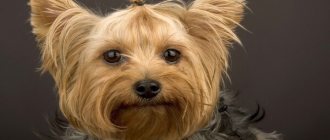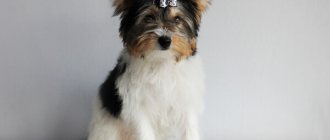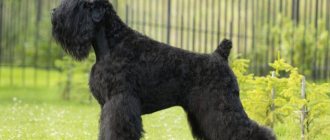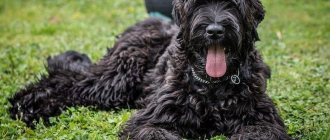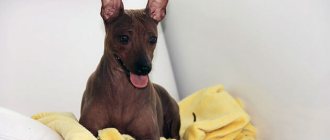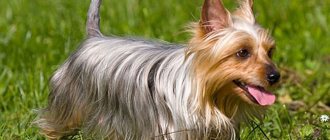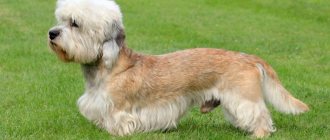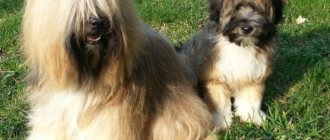02/26/2020 490 Dog breeds
Author: Olga
Several varieties of Yorkshire terriers - from fairly large maxis to tiny baby Yorkies - will allow owners to choose a dog to suit their taste. After studying the reviews, mini terriers are often preferred due to their small size and cute appearance. However, individuals of the standard category are stronger and more active. They live longer and do not require close attention, which must be taken into account when choosing a pet.
[Hide]
Description and characteristics of the breed
Despite their small size and toy appearance, York Terriers have a breed history that dates back more than a century. Their flexible nature and easy care make keeping a pet in an ordinary apartment simple and easy.
The development of Yorkies becomes less intense by 9-10 months, and at 12 months the dog is considered fully formed.
Story
There are different versions of the origin of the Yorkie breed.
Among its ancestors the following dogs are called:
- Manchester Terriers. It is believed that weaving mill workers decided to breed a variety of Manchester dogs. Representatives of the new line initially had a longer body and were heavier than the current Yorkshire terriers.
- Waterside Terriers. Found in the late 18th and early 19th centuries. in the lands of northern England, in the counties of Yorkshire and Lancashire. These small dogs were often kept by peasants for protection from small rodents and taken with them on trips by traders.
- Maltese (Maltese). It is believed that this breed was involved in crossbreeding with terriers to improve the quality of the Yorkie's coat.
- According to some experts, Yorkies could become descendants of breed varieties brought to England in the 18th century: Paisley, Clydesdale, and Skye terriers.
The request returned an empty result.
The Yorkshire Terrier became an independent breed after its recognition in 1886. Twelve years later, the first club dedicated to her was founded. Yorkies were first presented at a post-war exhibition in 1947. It was after the end of World War II that the popularity of Yorkies began to grow, and millions of people around the world acquired pets of this breed.
Breed standard: main characteristics
There are four main sets of rules for judging Yorkshire Terriers:
- Fédération Cynologique Internationale (FCI) standard;
- standard of the Russian Cynological Federation;
- English standard;
- American standard.
The standard approved by the Fédération Cynologique Internationale is common to the Yorkie breed. It includes a set of parameters recorded and approved in countries where animals of this breed are bred. Therefore, the listed size and weight standards have slight differences in numbers.
A brief description of the main characteristics of Yorkshire Terriers:
- life expectancy, on average, 12-16 years;
- weight of an adult animal: male - up to 3 kg, female - up to 2.7 kg;
- no growth standards have been established; most adult representatives of this breed grow from 15 to 25 cm at the withers;
- standard color – steel-blue;
- moderate activity;
- upbringing is simple, they learn well;
- the difficulty of care is increased; special attention must be paid to the condition of the coat;
- they treat children well and love to play with them;
- strangers are perceived with distrust, it takes time to adapt;
- calm attitude towards other animals, socialization required;
- The original purpose was protection from rodents, now it is a decorative breed, a family friend.
York Terrier: signs of the breed standard
Calculation and features of weight
The weight of a Yorkie depends primarily on the weight of its parents. If a dog is overweight or underweight, this will affect the size of its offspring. The breed has a property: over a generation, the weight of the litter can change.
Yorkie weight features:
- The standard Yorkie weight scale ranges from 1.35 kg to 3.1 kg;
- many specimens of the breed often gain a little more weight - up to 3.5 kg, and some even up to 4 kg;
- Yorkshire terriers reach full weight at approximately one year of age.
There is a method for calculating the weight of an adult. The weight of an eight-week-old puppy is multiplied by three, and the resulting figure accurately reflects the weight of an adult animal.
For example, a two-month-old puppy weighing 700 g will potentially have an adult weight of 0.7 x 3 = 2.1 kg. To determine the exact future weight of your pet, you must use sensitive scales.
The table shows average weight gain data for Yorkie puppies.
| Period | Average weight |
| at birth | from 0.09 kg to 0.13 kg |
| 1 month | from 0.26 kg to 0.48 kg |
| 2 month | from 0.45 kg to 0.96 kg |
| 3 month | from 0.68 kg to 1.34 kg |
| 4 month | from 0.88 kg to 1.68 kg |
| 5 month | from 1.05 kg to 2.04 kg |
| 6 month | from 1.14 kg to 2.45 kg |
| 1 year and 6 months | from 1.36 kg to 3.10 kg |
The slightly larger size and weight of Yorkies are considered normal. It is undesirable for adult animals to weigh less than 1.3 kg.
Varieties
When classifying York Terriers, they are usually classified into one of four groups:
- standard;
- maxi;
- mini;
- baby
Standard
Standard Yorkshire Terrier
This category usually includes terriers whose weight ranges from 2 to 3 kg. Descriptions of the Russian and English standards, approved by the FCI for Yorkies, provide for the weight of adults up to 3 kg 100 g. The structure of the muzzle is close to the classic one - not shortened and not too elongated.
Maxi
Dogs whose weight exceeds the upper limit of the standard range are classified as maxi. The largest representative of Yorkshire dogs is the dog, whose description is noted in the standard of the American Kennel Club. Its weight is 5.5 kg. No other features have been recorded in this specimen of the breed.
Mini
Yorkshire Terrier mini
Mini-Yorks include terriers, whose weight is about 2 kg. They are usually smaller in size and have a more fragile musculoskeletal system.
Caring for them is more difficult because:
- It is necessary to ensure that the dog does not stay on sofas, chairs, beds and other objects. If she accidentally falls or jumps onto the floor, she can damage her bones.
- It is not recommended to take miniature Yorkies into families with small children. A child playing with a dog may miscalculate his strength and also cause harm to its bones.
- There are some differences in breeding for this category. The poor health of females does not allow them to bear and give birth to offspring normally. This process requires knowledge and professional skills.
In the Mini Yorkie group, the smallest representatives of the breed are also distinguished. They are called micro-Yorks (super-mini). The weight of these tiny dogs barely reaches 1.5 kg. Such pets are not suitable for keeping at home, since in most cases they do not have sufficient health (weakness of the skeletal system). Their lifespan is shorter than that of standard Yorkie terriers.
Baby (baby face)
A characteristic feature of Yorkies in this category is a special type of muzzle that differs from generally accepted standards. Normally, its length is approximately comparable to the length of the skull. In baby Yorkshires it is no more than one third and resembles a child's or doll's face.
Other features that distinguish a babyface:
- low position of the ears - below the level of the forehead;
- large, slightly bulging eyes - the look seems surprised;
- The nose is set higher and turned up.
Baby
Despite the touching appearance, due to the structure of the dog's muzzle, some problems arise. Therefore, pets of this species require increased attention and care.
Owners should be aware of properties such as:
- risk of eye injury due to their protrusion;
- tendency to conjunctivitis;
- predisposition to tooth loss;
- makes snoring and grunting sounds due to the displacement of the nasopharynx.
Duration and life cycle
Yorkshire Terriers, which belong to the breed standard, live on average from 12 to 15 years. Some individuals reach twenty years of age.
In their life cycle, dogs go through several stages of growth:
- Newborn. The period from birth to 7 weeks of age. It is characterized by accelerated growth and rapid weight gain - within a few days the weight can double. York Terriers cannot see or hear from birth until they are two weeks old. They begin to open their eyes and catch sounds well in the third week. Around the same time, they begin to move around and learn to walk.
- Puppy. The period from the eighth week to one year. It is divided into approximately two phases: before six months and after, when the puppy is already considered a “teenager”. This stage is characterized by completeness and even excess energy, extreme curiosity. The terrier develops its character and habits.
- Maturity. Once a Yorkie reaches one year of age, it is considered an adult. However, for another three years it can be called a “young” individual. The period from four to eight years is simply “adulting”, or mature.
- The period after eight years for Yorkies, as for many decorative breeds, is considered the approach of old age. However, there are no officially established age standards. Many individuals who have reached the eight-year mark are full of health and energy. Some signs of aging may appear after ten years of life, when the activity of York Terriers decreases slightly. Sleep time usually increases, the dog becomes less restless and playful as before.
For the Mini Yorkie category, the age difference is shorter. Because they tend to be less robust and more susceptible to injury, their life cycle averages seven to nine years.
Unrecognized colors
It is worth noting that not all dogs fit the described breed standard. There are a considerable number of terriers that have rather unusual colors. Unrecognized colors that do not fit the standard include the following six types of coat colors.
Biro York
These dogs are very similar in appearance to Biewer Yorkies. Their main feature is that they do not have the gene that is responsible for the appearance of black fur. That is why such Yorkies are only light in color.
Additional Information! This variety of Yorkies appeared relatively recently and therefore they do not have a standard.
Beaver York
The Biewer Yorkie is a rare breed of Yorkie.
They are quite rare. Biewers look unusual; their appearance is in many ways similar to Biro-Yorks. They are also painted in light colors. However, some dogs have darker fur. Most often it occurs on the head. The body is painted white, sometimes with a silver tint.
Golddust
Such dogs are considered the rarest, since they are not found as often as others. The main distinguishing feature of these dogs is their unusual golden coat color.
Until 2007, they could not be classified into any breed. However, in the middle of this year they were officially identified as a separate breed called “Golddust”. The homeland of these dogs is Germany, but today they can be found in other countries.
Mermaid
These are quite beautiful and unusual dogs that can be called mermaids. This variety was bred relatively recently in Russia. These dogs differ from other animals in their long and thick hair. It is painted golden, with a slight yellowish tint.
Chocolate
The Chocolate Yorkie is one of the most beautiful representatives of the breed.
Sometimes dog breeders decide to get themselves chocolate terriers. They, like the silver Yorkie, have a fairly thick coat. At an early age, such dogs have softer hair. However, over time they become rougher. The coat is dyed dark. On the head it is completely black, on the body it is slightly lighter.
Important! Chocolate York Terriers have a uniform coat, without multi-colored spots.
Black
Dogs with jet-black fur are considered quite rare. Therefore, most black terriers have a grayish or brownish coating on the surface of the body. Even if the dog was perfectly black at an early age, over time its shade may change slightly and become lighter.
Character and behavior of dogs
Despite the fact that each pet has its own, unique character traits, the breed has features common to all its representatives.
Typical characteristics of Yorkies include:
- Energy, activity. Characteristic of most individuals of the breed. However, in recent years, among Yorkies there have often been dogs with a more balanced, phlegmatic character.
- High intelligence, intelligence. Pets often use these qualities for their own benefit in order to get what they want through cunning. If the dog manages to be captivated by the learning process, its training does not cause any particular difficulties.
- The desire for independence, stubbornness, perseverance. These qualities are characteristic of all varieties of terriers, including Yorkshire. If the owner does not let the pet know who is in charge in the family, the dog will consider this its privilege.
- Hunting instinct. The Yorkie breed has not lost its original hunting inclinations. They naturally perceive every creature smaller than themselves as prey. Therefore, when walking terriers, owners need to be especially careful.
- Protecting one's territory from the invasion of other, even larger, animals. In unusual conditions, the dog feels less confident and may become confused.
- Deep affection for owners and family members. Sincerity and spontaneity in expressing your feelings.
Pros and cons of the breed
When caring for dogs, minor difficulties may arise:
- Dogs cannot tolerate cold and extreme heat; to lie down, they need to choose a suitable place away from heating devices and not in a draft.
- In winter, dogs must be taken for walks in special overalls.
- During the non-show period, the dogs' coat needs to be cut short and constantly combed.
- Once a week, dogs need to brush their teeth, examine and clean their ears, bathe them, trim their nails once a month, remove matted hair between their toes, and wipe their eyes daily.
- On the back of the body, urine marks will be visible on light fur.
All the inconveniences that arise when caring for a pet are fully compensated by the fact that a small, but very loyal, curious, beautiful animal will always be happy to wait in the owner’s house, with which it is not even necessary to go for a walk, because it is easy to train to the tray. But walks for Bievers are still very necessary and important, because without physical activity in the fresh air, dogs begin to get sick.
The White Yorkie is a four-legged friend who has good health and a stable psyche. It is easy to accustom a dog to what the owner wants from him; the main thing is to start raising the dog as early as possible.
If any representative of the Yorkshire Terrier lives in the house, regardless of coat color, he will be loved by both adults and children. Gradually, the dog will turn into an important and necessary member of the family, will become a real living treasure, without which people will be sad.
Care and maintenance
To provide your Yorkshire Terrier with comfortable conditions and proper care, you need to prepare the appropriate supplies. Compliance with feeding rules and hygiene procedures will help raise and maintain the health of your pet.
Rules of care
Keeping Yorkies differs little from the usual set of rules common to caring for all dogs:
- Wash your pet daily - carefully wipe the eye area with a damp, warm swab. You can use a solution of boric acid (2%) or furatsilin for washing. To prevent the fur from getting into the eyes, it is collected in a bun on the top of the head or shortened.
- Once a week, clean the ears with a cotton pad and a special lotion or balm that dissolves wax deposits. If necessary, excess hair is removed from the ears.
- The dog's teeth are brushed weekly with paste or powder without aromatic additives. You need a brush with soft bristles, you can use a children's brush. To prevent dental deposits and massage the gums, your pet should buy a special bone at the pet store.
- The coat of York Terriers requires special care. It is recommended to brush it daily with a massage brush. You can wash the coat once a week with a mild shampoo and once a month with a special deep cleaning product. It is better to give your pets a haircut after they are one year old.
- Nails should be trimmed at least once a month. The procedure is needed not only for beauty, but for safety reasons: long nails prevent the dog from placing his paw straight and cling to obstacles. It is recommended to trim your nails after a warm bath - they will get wet and soften.
- The Yorkie breed belongs to the decorative group. They can use a tray to perform their natural needs and therefore need less walking. However, to improve the health and full development of dogs, you need to walk them 2-3 times daily. In winter, it is recommended to dress your pets in special clothing to prevent snow from getting into their fur and causing hypothermia.
- Choose a place to keep your Yorkie in a house or apartment that is convenient and does not interfere with the movement of people. It is not advisable to place a bedding or basket (box) for a terrier in drafts or close to heating appliances. It’s good if the pet tries to choose its own place.
- Bowls with food and water are placed in a protected place, otherwise the terrier may drag food to more secluded corners. Utensils should be kept clean. There should always be fresh drinking water in one of the bowls.
- To protect against diseases, Yorkie puppies must be vaccinated. This should be done in veterinary clinics. Dogs are given their first vaccination at the age of 8-9 weeks using Nobivac Lepto and NobivacDHPPi vaccines. Then a series of vaccinations against certain types of diseases is carried out at three and a half, four to five months and at six months. Then the procedure is done annually at the same time.
The video shows how to care for Yorkshire Terriers. Filmed by Max Ivanov.
Tools and accessories
Before placing your Yorkie pet in your home, you need to purchase all the items necessary for its maintenance so that the dog is comfortable.
List of required accessories:
- bed (mattress, bedding, rug) according to size;
- bowls for food and water;
- leash and collar;
- tray or special diapers for natural needs;
- toys.
Care products and tools:
- massage brush and metal comb (for matted strands);
- special liquids (gel, shampoo, conditioner) for hair care;
- eye cleansers (boric acid, furatsilin);
- ear cleaners;
- scissors and nail file;
- toothbrush, paste (powder).
What and how to feed?
It is important to maintain balance in the diet of York Terriers. Since dogs eat small meals, the food must be rich in nutrients. It is also necessary to follow a feeding schedule, which varies depending on the age of the dog.
Recommended and unwanted products
It is recommended to feed York Terriers the following types of food:
- boiled meat (chicken, beef) - approximately 50% of the diet;
- cereals - preferably rice and buckwheat, wheat and millet are acceptable;
- fermented baked milk, kefir, yogurt;
- low-fat cottage cheese;
- boiled vegetables: carrots and zucchini;
- fruits: apples, banana, melon can be used;
- boiled sea fish (once a week).
You can feed dogs special dry food and canned food, but it is advisable to alternate them with natural products.
The following foods should not be given to your dog:
- bones;
- pork meat;
- sweets, confectionery;
- potato dishes;
- freshly baked bread;
- beans, beans, peas;
- raw fish;
- raw eggs.
The video shows feeding and prohibited foods for your Yorkie. Filmed by the Yorick Vulkashka channel.
Diet
The daily number of meals depends on the age of the dog:
- up to 3 months – up to 6 times;
- from 3 to 6 months – 4 times;
- from 6 to one year – 3 times;
- older than one year – 2 times.
The approximate amount of food per meal is calculated based on the weight of the animal: 1 tbsp. spoon of food per 500 g of mass.
Possible diseases and their treatment
With careful care and timely vaccination, Yorkshire terriers are little susceptible to diseases because they are in good health. If signs of illness appear, you should definitely contact a veterinarian.
Digestive system diseases
When the diet is inadequate or unbalanced, the following diseases may occur:
- Inflammation of the pancreas (pancreatitis). Symptoms: increased gas production, vomiting, lethargy, pain in the abdominal area, loss of appetite. In addition to drug treatment, the dog needs a strict diet that excludes high-fat foods.
- Diarrhea (diarrhea). At the first sign, you should not feed your pet for 24 hours. Feeding is resumed with low-fat cottage cheese, rice porridge and water. Minor glitches occur if a low-quality product is eaten.
- Prolonged diarrhea, accompanied by vomiting and fever, is a symptom of serious illness. Among them may be dysbacteriosis, liver or kidney pathology, hepatitis.
Allergy
Yorkies are known for their tendency to allergies, the appearance of which is accompanied by the following signs:
- inflammation of the nose;
- irritation of the mucous membrane of the eyes;
- hives;
- redness of the skin.
The most common causes of allergies are:
- some types of medicines;
- plant pollen;
- individual food products (in particular, vegetables and fruits);
- incorrectly selected cosmetics and detergents.
If an allergy occurs, qualified medical assistance is required. Self-treatment should not be carried out.
Oral diseases
With proper care, the likelihood of these diseases is minimal.
Among the most common of them are:
- Deposits on teeth. Appears due to the properties of Yorkie saliva. For prevention, you need to regularly brush your pet’s teeth and carry out special cleaning every six months. Otherwise, by the age of 5-6 years the dog may lose several teeth. Plaque can cause bad mouth odor and negatively affect digestion.
- False polydenty. Occurs when baby teeth do not fall out on time. A double row of teeth leads to malocclusion, inflammation of the gums and the formation of tartar. In addition, disturbances in the growth of the main teeth are possible. Polydentia is eliminated surgically - baby teeth are removed under anesthesia.
Musculoskeletal disorders
Overweight and underweight individuals are predisposed to musculoskeletal disorders. Mini Yorkies are especially susceptible to them.
Types of violations:
- Pathology of the hip joint. It often occurs in dogs between 6 months and one year of age. Signs: acute pain when moving, limping. To treat the disease, surgery is performed.
- Ataxia, a weakened state of the muscles. It manifests itself in weakness of the leg muscles, the dog may have difficulty breathing. There are no effective methods for eliminating this pathology yet.
- Cruciate ligament rupture. Occurs as a result of excessive stress or when the pet is overweight. Predisposition to this disease can be inherited. If a rupture occurs, the dog is given a tight bandage or plaster. If necessary, surgery can be performed.
- Fractures and dislocations. Yorkies' playful nature can lead to accidental falls and injuries. The risk of injury is especially high in miniature Yorkies.
Hydrocephalus
Dropsy of the brain occurs as a result of the accumulation of cerebrospinal fluid. The congenital form of the disease can be determined by the characteristic deformation of the dog's head. The disease is treatable, but only with timely diagnosis.
Signs of the disease:
- loss of coordination;
- convulsions;
- vision problems;
- Difficulty breathing may appear and then stop.
Shiver
There are several reasons for trembling in pets:
- Cold. Due to their relatively small body weight and thin layer of fat, dogs are acutely aware of low air temperatures. If the apartment is not warm enough, the pet’s sleeping place should be well insulated, placed closer to heating devices or use a heater.
- Stress. Yorkies can become very distressed when they are reprimanded or punished. Causes of anxiety include loud, sharp sounds or changes in environment. Trembling can even appear from joy - anticipation of a treat, a new toy or a long-awaited walk.
- Certain types of diseases. The most common cause is low blood sugar. Symptoms of the disease: increased salivation, lethargy, decrease and loss of appetite, even loss of consciousness is possible.
How to care for a black Yorkshire terrier
Regardless of color, the Yorkshire Terrier is a decorative small dog that requires fairly careful care. Below we will discuss the main nuances and features of keeping Yorkshire dogs: general care, nutrition, coat maintenance, health.
Keeping a Yorkshire Terrier
Like any dog, the Yorkshire Terrier must receive a regular set of procedures aimed at maintaining the health, appearance of the pet, as well as its emotional state.
Yorkshire on a walk
The owner of a Yorkshire Terrier must provide the pet with regular walks: it is advisable that the dog goes outside three times a day. Twice it can be a short walk to do toilet chores, and the third walk should be long and eventful. The Yorkshire Terrier needs the opportunity to burn off its energy: run, play with other dogs or the owner.
The puppy can be outside only after the necessary vaccinations.
Also, an important part of care procedures is the prevention of various ailments and health problems. These include:
- Annual vaccination (infections, viruses, rabies).
- Quarterly treatment for helminths.
- Protecting your dog from ticks during the season (April to October).
- Cleaning ears, eyes, teeth, trimming nails - as needed.
Methods of protection against ticks
Yorkshire Terrier nutrition
Also, the owner of a Yorkie must decide what he will feed the pet. During the first weeks, while the puppy adapts to its new home, its diet should be exactly the same as that of the breeder. Gradually, the owner can switch the dog to a different type of food if there is such a desire or need.
Many Yorkshire owners feed their pets dry food. Complete ready-made diets should be selected based on their class - the best option would be “holistic” or “super-premium” food. These diets contain high quality ingredients and do not contain flavorings, chemicals or allergy-causing components, which is very important for the delicate body of a small dog.
Feeding your dog dry food is very convenient
When choosing food for your Yorkshire terrier, you need to pay attention to the lines for small (decorative) breeds of dogs. It will be indicated on the packaging: Mini or Small Breed. The following brands of food have proven themselves well: “Akana”, “Hills”, “Nau”, “Origen”, “Go”, “Eagle Pak” and the like.
Examples of holistic dog foods
If feeding dry food is unacceptable for the Yorkie owner, you will have to work hard to create a natural diet. The basis of natural nutrition should be raw, fresh meat (veal, rabbit, turkey, chicken), and the dog should also receive fresh vegetables and fruits, lactic acid products (without additives, kefir, low-fat cottage cheese) daily. The diet also includes chicken or quail eggs, seasonal greens and berries, offal, and sea fish.
Feeding the dog from the table is strictly prohibited!
To ensure that your new friend is always healthy, you need to know what to feed your Yorkshire Terrier, since properly selected food is the key to the health of any dog. We will examine this issue in more detail in a special article.
Yorkshire Terrier coat care
Proper care of your Yorkie's luxurious coat is a big contribution to your pet's excellent appearance. First, the owner must determine for himself whether he will let the dog grow long hair (this is necessary for show pets), or whether he will regularly visit the groomer for a haircut. In both the first and second cases, basic coat care will be the same, with some nuances.
Of course, short hair is easier to care for, but the fact that a Yorkie wears a haircut does not relieve the owner from the hassle of grooming! Taking care of your Yorkie's coat begins with washing: dogs of this breed are washed every 10-14 days using professional pet shampoo.
In the pet store you can choose a line of cosmetics specifically for Yorkies
The shampoo should be moisturizing, without aggressive detergent components. Good options for the Yorkshire Terrier:
- Artero Hidratant Shampoo.
- Iv SanBernard Mela Verde Shampoo.
- Bio Groom Protein – Lanolin Shampoo.
- 1 All Systems Smoothing Keratin Shampoo.
For black Yorkshire terriers, you can choose a special shampoo that additionally preserves the shade, making it more radiant and rich. In this case, among the brands listed above, you need to look for shampoos marked “for black dogs” or simply “black”.
However, one shampoo is not enough for a Yorkshire Terrier. Usually owners use an additional mask or conditioner. They are applied after washing, maintaining the required time (as indicated by the manufacturer on the packaging). Yorkie's coat needs additional hydration, restoration and nutrition; these are the characteristics that the chosen cosmetics should have.
You can ask your breeder or groomer for advice on choosing cosmetics.
Another important step in grooming is combing. Your Yorkshire Terrier needs to be brushed regularly, once every two to three days. The owner should have several combs in her arsenal: a massager with metal teeth without balls at the ends, a comb with long smooth teeth, a brush made of natural bristles.
You should never comb wet fur - breeders recommend lightly combing the dog before washing, and then, after drying it well with a hairdryer, combing the Yorkie's coat thoroughly. But, doing this “dry” is also prohibited - before picking up a comb, you need to spray the dog’s fur with a special spray that makes combing easier, adds shine, and simplifies the removal of tangles.
Video - How to care for your Yorkie: choosing cosmetics
Training and education
Puppy training can begin at two months of age. It is not recommended to delay the beginning, since Yorkies, with their innate cunning, easily learn to manipulate their owners. Training should be carried out in the form of a game and with the pet in a positive mood.
As a result of training, the dog must learn and follow the main commands:
- "To me!";
- "Place!";
- "Near!";
- "Ugh!";
- "Sit!";
- "Stand!".
In the first days after the Yorkie appears in the house, you should accustom the puppy to its place. To do this, they take him to the bed several times and clearly pronounce the command “Place!”
Education will be more successful if you follow the following rules:
- It is important to accustom the puppy to its name; this will greatly facilitate communication between the owner and the pet. When reprimanding, the name is not spoken so as not to evoke associations with incorrect behavior.
- Training requires regularity and consistency. You should choose time free from other activities, and take into account the pet’s health and mood.
- For Yorkies, short (10-15 minutes) but frequent exercises are recommended. During a long lesson, you need to take 2-3 breaks, when you can play with the owner.
- Correct behavior and execution of commands should be rewarded with affectionate intonation, a keyword and a treat. The reward is given immediately after a correctly executed command, and reprimand is also given without delay.
- Despite the general positive attitude, when teaching the command “Fu!” Maximum rigor must be exercised. The command is pronounced in a menacing, low tone.
- If your Yorkie acts incorrectly or disobediently, you should never hit him, shout at him, or pick him up by the scruff of the neck and shake him. You can use a sharp sound - for example, clap your hands loudly.
Choosing a pet
To choose a healthy pet with good heredity, you need to know where to look for puppies and what to look for during examination.
Depending on the age of the pets, they adapt to new conditions in different ways:
- Babies 2-3 months old. They attract attention with their cute, cute appearance and make you want to play with them. But, like small children, puppies will require a lot of attention and care. If you leave them alone for a long time, they will be very worried and bored. At night, small puppies can get scared and whine, waking up their owners.
- Puppies 6-7 months old. This age is quite suitable for most dog lovers. Usually puppies are already toilet trained and know a set of basic commands. Their teeth have already changed, real fur has grown - you can appreciate the constant color.
- Adult York Terriers. Adult animals are abandoned due to the birth of children and relocations. Some owners are unable to maintain a dog or lose the desire to work with it. It would be a mistake to think that an adult Yorkie will not be able to get used to it and make friends with its new owner. This option is well suited for older people.
Where to buy and how much does it cost?
Basic rules when buying a Yorkie:
- It is better to look for a future family member and friend in specialized nurseries and clubs.
- At exhibitions of decorative breeds you can meet breeders who own Yorkshire terriers.
- You should not purchase terrier puppies from markets or from other people. In such cases, there are no guarantees in terms of the pedigree and health of the pet.
Professional breeders and nursery staff conscientiously perform their duties and provide the puppies with proper care. They are interested in carefully selecting males and females for breeding, since this is the only way to obtain full-fledged breeding offspring.
Prices for Yorkshire puppies vary, on average, from 15 to 60 thousand rubles. Some copies are offered at a price of 120-150 thousand rubles.
Prices depend on a number of reasons:
- the dog has a good pedigree, confirmed by documents from the Cynological Federation;
- participation in exhibitions and competitions, awards;
- health status;
- color;
- quality medical care (vaccinations);
- degree of training;
- character traits.
Criterias of choice
When choosing a pet Yorkie, it is useful to know the following points:
- When visiting a kennel or breeder, you should inspect the conditions in which the mother and puppies live. It’s good if the dogs are well-groomed and lively. The cage should be comfortable and spacious; In the best case, it will be a clean, dry enclosure with a place to sleep, eat, play, and toilet.
- When choosing a puppy, you should say for what purpose the dog is being purchased - just for the home or will participate in exhibitions. This information is important because even in the same litter there can be puppies with different characteristics.
- A competent breeder can confidently and thoroughly answer all questions. If he values dogs and his work, he will definitely ask where and how the puppy will be kept, what they will feed him and how to care for him.
- Typically, breeders give away Yorkie puppies starting at 4 months of age. A standard individual should weigh about 1-1.2 kg at this time, a mini-York should weigh about 0.7-1 kg. If the puppy's weight is less than these standards, you should be careful - health problems are possible.
- The dog must have all necessary vaccinations.
Sorry, there are no surveys available at this time.
Biewer Yorkshire Terrier - description of the breed
The appearance of the Biewer Terrier can be briefly described by the following points:
- Compact dimensions;
- Rectangular body shape;
- Strong short legs;
- Dark, small eyes;
- Scissor or level bite;
- High tail;
- Interesting color: from white to blue;
- Long coat that flows beautifully to the sides.
Black and white Yorkies are very small. On average, their height is about twenty centimeters. The largest individuals are twenty-seven centimeters tall. The dogs have an athletic body, muscular croup, and voluminous chest. The weight of the male does not exceed three kilograms. Females are larger - up to three and a half kilograms. The body of the animal is proportional. The body is compact, the head is small, the limbs are straight.
Biewers' tails are not usually docked. It is raised high and shaped like a sickle. When moving, the tail can be either raised or lowered. If the tail is docked, then at least two-thirds of the length is left. The animal's paws are smooth, parallel, and have well-developed joints. The black and white Yorkie moves very easily, and with good care, even in old age, maintains excellent joint health.
Biewer Yorkshire Terriers have a very smart muzzle, a small head, and a slightly flattened skull. The eyes are located straight and have a round shape. The animal's nose is like a tiny black button, and its lips always fit tightly to its teeth. The animal's ears are set wide apart and resemble small triangles in appearance. The tips of the ears are directed towards the top. This Yorkie looks cute and has an interested look.
Video
The video shows recommendations for choosing Yorkie puppies. Photographed by Oksana Petrova.
Was this article helpful?
Thank you for your opinion!
The article was useful. Please share the information with your friends.
Yes
No
X
Please write what is wrong and leave recommendations on the article
Cancel reply
Rate the benefit of the article: Rate the author ( 2 votes, average: 5.00 out of 5)
Discuss the article:
